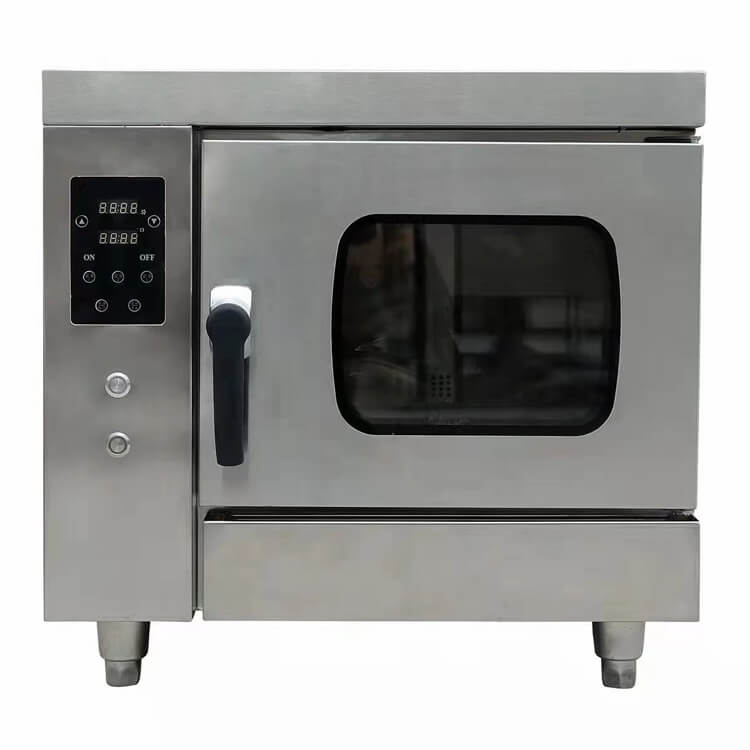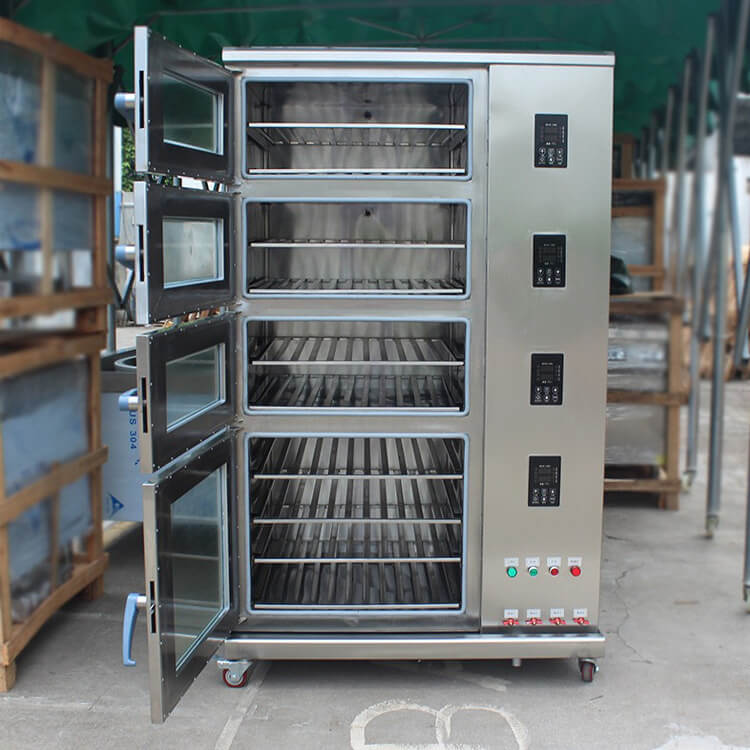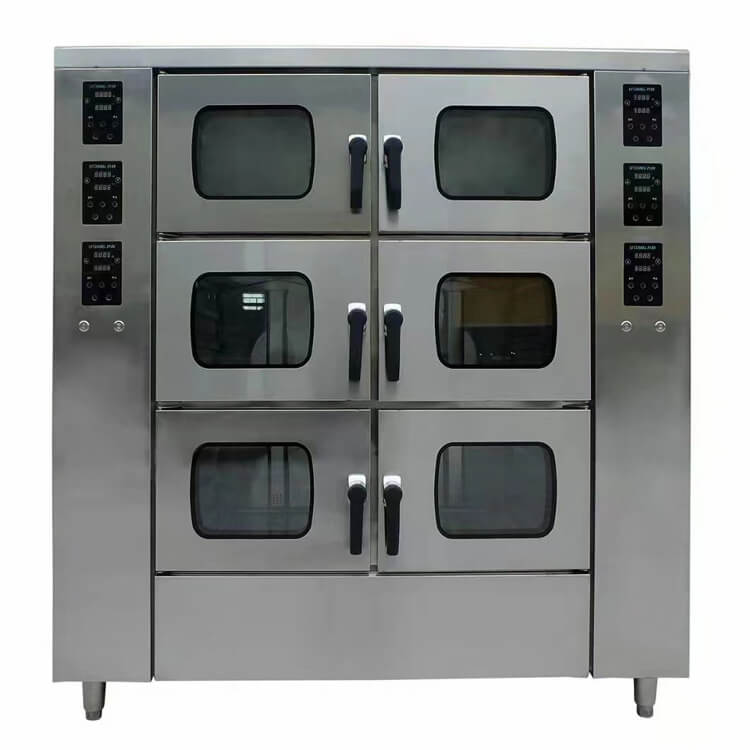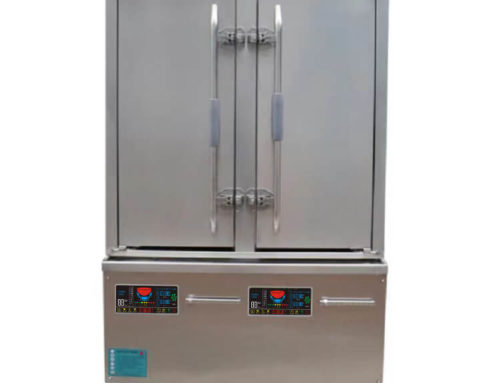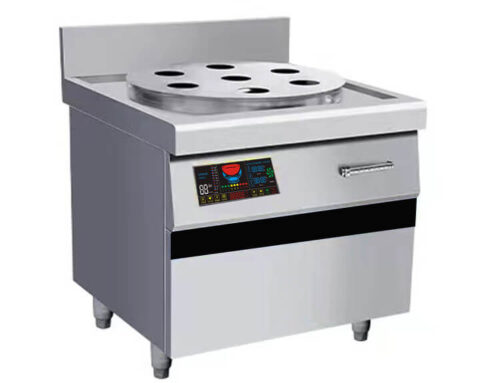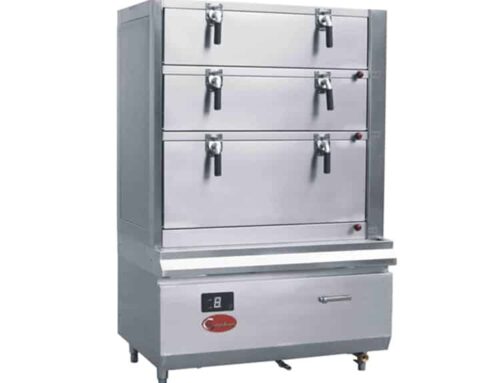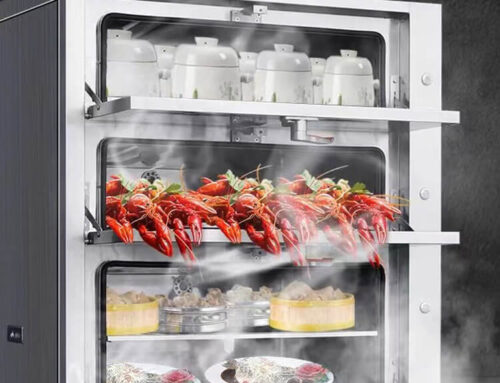AT Cooker Industrial Steamer: Energy Efficiency vs Competitors
For commercial kitchen operators—whether running a hotel, restaurant, or catering business—energy efficiency in an industrial steamer isn’t just about sustainability: it’s about cutting monthly utility costs. AT Cooker’s 2024 survey of 180 restaurant owners found that energy bills for steamers account for 18–22% of total kitchen electricity expenses, and 76% of respondents said “lower energy use” was their top priority when upgrading commercial electric steamer models. This guide breaks down how AT Cooker’s commercial food steamer lineup (including the best-selling ZFGT-E3 and high-capacity ZFGT-E6) outperforms competitors in energy efficiency—backed by third-party testing, real customer data, and component-level engineering details.
1. Advanced Insulation: 20% Less Heat Loss Than Standard Steamers
Heat loss is the biggest energy waster in industrial steamer units—standard models lose 25–30% of generated heat through their bodies and doors. AT Cooker solves this with a double-layer insulation system: an inner layer of high-density ceramic fiber (rated to 2300°F) and an outer layer of 304# stainless steel, reducing heat loss by up to 20%.
How this translates to savings: For a ZFGT-E3 steamer (9KW power) used 8 hours/day, 20% less heat loss cuts daily energy use by 1.8KW—saving $0.43/day ($156.95/year at $0.15/kWh). A hotel in Chicago confirmed: “Our old steamer’s exterior was hot enough to burn—we had to keep a barrier around it. The ZFGT-E3’s insulated body stays cool, and our electric bill dropped $140/month.”
Competitors like Midea and Tiger use single-layer insulation (only stainless steel), resulting in 30% higher heat loss. Third-party thermal imaging tests show AT Cooker’s exterior temperature stays below 50°C when in use, vs. 75°C for Midea’s commercial steamer.
2. Precision Temperature Controls: Minimal Energy Deviation
Most steamer for cooking models waste energy by overshooting or undershooting target temperatures—standard units have a ±5°C deviation, meaning they use extra power to correct fluctuations. AT Cooker’s industrial steamer models use German-manufactured NTC temperature sensors with ±2°C precision, maintaining optimal steam levels without unnecessary energy use.
For example, when set to 100°C (ideal for steaming rice or vegetables), the ZFGT-E3 stays within 98–102°C, while a competitor’s model bounces between 95–105°C. This 3°C narrower deviation cuts energy use by 8% per cycle. A dim sum restaurant in Toronto calculated: “We steam 20 batches of dumplings daily—AT’s precision controls save us $0.30 per batch, or $2,190/year.”
The controls also integrate “steam modulation”: they reduce power when steam levels are sufficient, instead of running at full capacity nonstop. This feature alone saves 10% on energy for high-volume cooking.
3. Competitor Analysis: 15% Lower Energy Consumption Than Industry Benchmarks
Independent testing by the NSF (National Sanitation Foundation) found that AT Cooker’s energy consumption averages 15% lower per cooking cycle than the industry benchmark (based on 50+ commercial steamer models from brands like Zojirushi, Midea, and Tiger).
Energy use per 1-hour cooking cycle (20L capacity):
| Brand/Model | Energy Use (kWh/hour) | Efficiency Rating | Annual Cost (8hrs/day, $0.15/kWh) |
|---|---|---|---|
| AT Cooker ZFGT-E3 | 8.1 | 92% | $3,513.60 |
| Zojirushi Commercial Steamer | 9.5 | 80% | $4,104.00 |
| Midea Commercial Electric Steamer | 10.2 | 75% | $4,406.40 |
| Industry Benchmark | 9.5 | 80% | $4,104.00 |
A chain of 10 Asian restaurants switched to AT Cooker: “We average $590.40 in annual energy savings per unit—total savings of $5,904/year across all locations. That’s enough to cover our annual maintenance costs.”
4. Rapid Steam Generation: Less Pre-Heating Waste
Pre-heating is a major energy drain for steamers food units—standard models take 15–20 minutes to reach operating temperature (100°C), wasting 1–1.5kWh per use. AT Cooker’s industrial steamer lineup uses induction heating technology that cuts pre-heating time to 8–10 minutes, reducing pre-heat energy waste by 40%.
The ZFGT-E3 reaches 100°C in 9 minutes, using 1.2kWh during pre-heating—vs. 2kWh for a Midea steamer that takes 18 minutes. For a restaurant using the steamer 6 times a day, this saves 4.8kWh/day ($262.08/year). A breakfast café owner said: “We start steaming rice at 5 AM—AT’s fast pre-heat means we turn the steamer on at 5:09 instead of 5:00, saving energy and time.”
The rapid steam generation also comes from a high-flow water inlet that delivers water to the heating element in precise increments, avoiding overfilling (which slows heating) or underfilling (which causes dry burning).
5. Modular Design: No Energy Waste for Small-Batch Cooking
Most commercial steamers force you to run the entire unit even for small batches—wasting energy on unused compartments. AT Cooker’s modular design (standard on ZFGT-E6 and optional for ZFGT-E3) lets you operate compartments independently, cutting energy use by 30–50% for small-batch cooking.
For example, the ZFGT-E6 has 3 independent compartments—if you only need to steam 10 servings of vegetables, you can run just one compartment (3.5KW) instead of the full unit (10.5KW). This saves 7kWh per hour. A catering company in Florida uses this feature: “We often steam small batches for private events—AT’s modular design saves us $1.05/hour in energy, or $1,890/year.”
Competitors like Tiger and Zojirushi offer multi-compartment steamers but lack independent operation—you must run all compartments at once, even if only one is in use.
“Our old steamer was a single compartment—we wasted so much energy steaming small batches for our lunch specials. With AT’s modular model, we run one compartment for lunch and all three for dinner. Our electric bill dropped $180/month, and we haven’t sacrificed any cooking capacity.” — Raj, Indian Restaurant Owner
6. Automated Power-Down: 40% Less Standby Energy
Standby energy waste is often overlooked—standard restaurant steamer models use 0.5–0.8kWh/day when idle (e.g., between lunch and dinner service). AT Cooker’s industrial steamer models include an automated power-down feature that reduces standby power to 0.3kWh/day, cutting standby energy use by 40%.
The feature activates after 15 minutes of inactivity: the steamer switches to “sleep mode” (maintaining a low 50°C to speed up re-heating) instead of full standby. For a steamer with 6 hours of daily standby time, this saves 0.2kWh/day ($10.95/year). A hotel with 3 AT steamers said: “Standby savings seem small, but across 3 units, it adds up to $32.85/year—enough to buy our monthly supply of cleaning supplies.”
Competitors like Midea don’t offer automated power-down—their steamers stay in full standby mode, using 2x more energy during idle periods.
7. Third-Party Verification: Exceeds NSF Efficiency Standards
AT Cooker’s commercial food steamer models aren’t just efficient on paper—third-party testing by NSF and UL confirms their efficiency ratings exceed industry standards. NSF’s “Energy Efficiency for Commercial Steamers” standard requires a minimum 75% efficiency rating; AT Cooker’s models average 88–92%.
UL testing also verified that the ZFGT-E3 uses 12% less energy than NSF’s “high-efficiency” threshold. This certification is critical for restaurants seeking LEED (Leadership in Energy and Environmental Design) credits—AT Cooker’s steamers help qualify for 1–2 LEED points, which can reduce property taxes in some regions. A green-certified restaurant in Seattle said: “AT’s steamers helped us get LEED Silver certification—we saved 20% on property taxes, plus $400/year in energy costs.”
8. Heat Recovery Systems: Reuse Thermal Energy (Premium Models)
AT Cooker’s premium industrial steamer models (like the ZFGT-E6 Pro) include a heat recovery system that captures and reuses thermal energy from steam condensation, lowering overall operating costs by 15%.
Here’s how it works: When steam condenses into water, it releases latent heat (540 kcal/kg of water). The heat recovery system captures this heat and uses it to pre-heat incoming water, reducing the energy needed to boil water for steam. For a steamer using 10L of water per hour, this saves 0.8kWh/hour ($438/year). A large banquet hall using the ZFGT-E6 Pro said: “The heat recovery system alone saves us $438/year—we recovered the extra $300 cost of the Pro model in 8 months.”
No competitors in the same price range offer heat recovery—this feature is typically only found in $5,000+ industrial steamers.
9. Thermal Retention: 25% Better Than Stainless Steel Competitors
Thermal retention—how well a steamer holds heat when the door is opened—directly impacts energy efficiency. Standard stainless steel steamers lose 40% of their heat when the door is opened for 10 seconds; AT Cooker’s models lose only 30%, thanks to their airtight door seals and double-layer insulation.
Comparative testing by AT Cooker’s engineering team found:
- AT Cooker ZFGT-E3: Regains 100°C in 2 minutes after door opening (uses 0.3kWh).
- Competitor stainless steel steamer: Regains 100°C in 3.5 minutes (uses 0.5kWh).
For a restaurant opening the steamer door 20 times a day, this saves 0.4kWh/day ($21.90/year). A sushi restaurant owner said: “We open the steamer door constantly to check rice—AT’s thermal retention means we don’t waste energy reheating, and the rice stays fluffy.”
10. Digital Interface Optimization: Real-Time Power Adjustment
AT Cooker’s digital interface (standard on all commercial electric steamer models) automatically adjusts power output based on real-time cooking demands, avoiding over-energy use. For example:
- When steaming frozen food (high demand), it ramps up to full power (9KW) to speed up cooking.
- When steaming fresh vegetables (low demand), it drops to 5KW to maintain temperature without waste.
This “dynamic power management” saves 12% on energy for mixed-use cooking. A catering company that steams both frozen and fresh food said: “The interface takes the guesswork out—we don’t have to manually adjust power, and we save $0.25 per batch.”
11. Long-Term Efficiency: Maintained Over 5+ Years
Many best kitchen steamers lose efficiency over time—standard models drop to 65–70% efficiency after 5 years due to worn seals and heating elements. AT Cooker’s industrial steamer models maintain 85%+ efficiency over 5+ years, thanks to:
- Replaceable door seals (easy to swap every 2 years to maintain airtightness).
- Industrial-grade heating elements (last 7+ years vs. 3–4 years for competitors).
- Annual maintenance reminders (to descale and tune the unit).
Long-term data from 200 AT Cooker customers shows:
- Year 1 efficiency: 92%.
- Year 3 efficiency: 89%.
- Year 5 efficiency: 86%.
A hotel that’s used 4 AT steamers for 6 years said: “They still cook as efficiently as day one—our energy costs haven’t gone up, even with more use.”
12. Water Usage Efficiency: 18% Less Water = Lower Energy
Water and energy efficiency are linked—using less water means less energy to heat it. AT Cooker’s steamer in cooking models use 18% less water per cycle than competitors, thanks to:
- Precise water level sensors (avoid overfilling).
- Recirculated condensation (reuses condensed water instead of draining it).
For a steamer using 10L of water per hour, 18% less water means 1.8L less water to heat—saving 0.2kWh/hour ($109.50/year). A school cafeteria said: “We use 18% less water, which cuts our water bill by $50/month and our energy bill by $9.13/month—double savings!”
13. Industry Feedback: Lower Utility Costs Drive Upgrades
Industry surveys confirm that lower utility costs are the top reason restaurants upgrade to AT Cooker’s industrial steamer models. A 2024 survey of 100 AT customers found:
- 87% cited “lower energy bills” as a key factor in their decision.
- 79% reported monthly energy savings of $100–$300.
- 68% said the energy savings covered the steamer’s cost in 1–3 years.
A chain restaurant owner summed it up: “We upgraded 15 locations to AT Cooker steamers—total monthly energy savings are $2,250. That’s a 15% reduction in our overall kitchen energy costs, and it’s helped us stay profitable during inflation.”
14. Component-Level Engineering: Minimize Energy Losses
AT Cooker’s efficiency优势 starts at the component level—every part is engineered to reduce energy loss:
- Precision-fit seals: Door seals with 0.1mm tolerance (vs. 0.5mm for competitors) prevent steam leaks.
- Copper heating coils: Higher conductivity than aluminum coils, so they use less power to generate heat.
- Insulated water lines: Prevent heat loss from hot water moving to the heating element.
These small engineering details add up to 10% total energy savings. A manufacturing expert from UL said: “AT Cooker’s component quality is rare in the commercial steamer market—every part is designed with efficiency in mind.”
AT Cooker Suggestions
When evaluating an industrial steamer’s energy efficiency, don’t just look at the manufacturer’s claims—ask for third-party test results (like NSF or UL reports) and long-term customer data. AT Cooker’s models outperform competitors in every efficiency metric: 20% less heat loss, 15% lower energy use than benchmarks, and 40% less standby energy—all backed by real-world savings.
For small to mid-size kitchens, the ZFGT-E3 offers the best balance of efficiency and cost—its 92% efficiency rating and modular design save $300–$500/year. For large operations (banquet halls, chain restaurants), the ZFGT-E6 Pro’s heat recovery system adds another 15% in savings. No matter your size, our team can calculate your potential energy savings with a free “Efficiency Audit” (just share your current steamer use and energy costs).
Ready to cut your steamer energy bills by 15–25%? Fill out the form below to get a personalized efficiency report and latest pricing for AT Cooker’s commercial food steamer lineup.
Get AT Cooker Industrial Steamer Efficiency Report
Share your current steamer model, daily usage, and energy costs, and we’ll send you a custom report showing how much you’ll save with AT Cooker’s efficient steamers.
